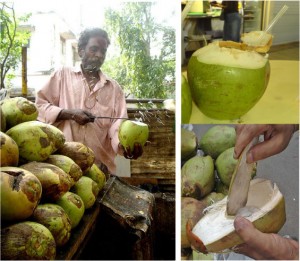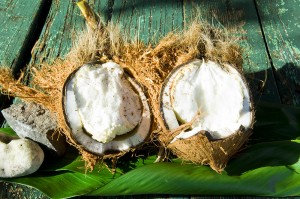Coconut is highly nutritious and rich in fiber, vitamins, and minerals. It is classified as a “functional food” because it provides many health benefits beyond its nutritional content. Coconut oil is of special interest because it possesses healing properties far beyond that of any other dietary oil and is extensively used in traditional medicine among Asian and Pacific populations.
So there you are stranded in the jungle or alone on some tropical island. Hopefully you have a machete, but that aside let me tell you about one of God’s greatest gifts; the coconut. If you’ve watched any variety of survivor shows you know the hard meat can be used as sun screen, but that’s probably as far as your knowledge goes; assuming of course you haven’t lived in the tropics.
Let me start by discussing the stages of edibility. Most in a tropical region would abstain from the old coconuts, as the meat is hard and not good for more than copra or food flavoring.
Young coconuts
This is the preference for eating. The milk is going to be sweetest at this point. I found one of the easiest ways to tell is by holding up the coconut and shaking it; if you hear fluid sloshing around then it is old, the younger fruit is full to the brim. Do not husk it because the shell around the meat at this stage is soft, so all you have to do is lob the top off with your machete; if the machete strikes a hard core then it’s probably aged. Drink and then split. The inside is soft and can easily be scrapped out with a spoon.
Old coconuts
At this stage you can husk it and expose the hard shell most people are familiar. The milk is not as sweet at this stage and can have a laxative effect, so for hydration stick with the young ones. Hold the shell and with the back of the machete strike either side of the shell causing it to fracture and it will split in half. In the Philippines locals would scrape out the insides and then squeeze the white milk out of the shavings and use them to flavor food; Tai food uses a lot of this true coconut milk. Most regions in the tropics use this old meat for copra, they use the husks to smoke the meat and then dry it in the sun so that the oil can be squeezed out in a press.
Sprouting coconuts
Believe it or not even a nut that has been laying months in the jungle floor and might have sprouted a young tree is still edible. These will not likely have liquid in the center, and will instead be filled with a partial or complete foam like core. Starting out as a little ball in the fluid and eventually expanding to fell the shell, this is a very sweet treat, although I don’t know that it has much nutritional value at this point.
Coconut Oil
While coconut possesses many health benefits due to its fiber and nutritional content, it’s the oil that makes it a truly remarkable food and medicine.
It is now known that the fat in coconut oil is a unique and different from most all other fats and possesses many health giving properties.
Coconut oil has been described as “the healthiest oil on earth.” That’s quite a remarkable statement. What makes coconut oil so good? What makes it different from all other oils, especially other saturated fats?
The difference is in the fat molecule. All fats and oils are composed of molecules called fatty acids. There are two methods of classifying fatty acids. The first you are probably familiar with, is based on saturation. You have saturated fats, monounsaturated fats, and polyunsaturated fats. Another system of classification is based on molecular size or length of the carbon chain within each fatty acid. Fatty acids consist of long chains of carbon atoms with hydrogen atoms attached. In this system you have short-chain fatty acids (SCFA), medium-chain fatty acids (MCFA), and long-chain fatty acids (LCFA). Coconut oil is composed predominately of medium-chain fatty acids (MCFA), also known as medium-chain triglycerides (MCT).
The vast majority of fats and oils in our diets, whether they are saturated or unsaturated or come from animals or plants, are composed of long-chain fatty acids (LCFA). Some 98 to 100% of all the fatty acids you consume are LCFA.
The size of the fatty acid is extremely important. Why? Because our bodies respond to and metabolize each fatty acid differently depending on its size. So the physiological effects of MCFA in coconut oil are distinctly different from those of LCFA more commonly found in our foods. The saturated fatty acids in coconut oil are predominately medium-chain fatty acids. Both the saturated and unsaturated fat found in meat, milk, eggs, and plants (including most all vegetable oils) are composed of LCFA.
MCFA are very different from LCFA. They do not have a negative effect on cholesterol and help to protect against heart disease. MCFA help to lower the risk of both atherosclerosis and heart disease. It is primarily due to the MCFA in coconut oil that makes it so special and so beneficial.
There are only a very few good dietary sources of MCFA. By far the best sources are from coconut and palm kernel oils.
Coconut in Modern Medicine
I don’t know that I agree with all of these, but here are some of the things coconuts are being used to treat. Coconuts are amazing but they are not a miracle cure, so take these for what they are worth.
Modern medical science is now confirming the use of coconut in treating many of the above conditions. Published studies in medical journals show that coconut, in one form or another, may provide a wide range of health benefits. Some of these are summarized below:
Kills viruses that cause influenza, herpes, measles, hepatitis C, SARS, AIDS, and other illnesses.
Kills bacteria that cause ulcers, throat infections, urinary tract infections, gum disease and cavities, pneumonia, and gonorrhea, and other diseases.
Kills fungi and yeasts that cause candidiasis, ringworm, athlete’s foot, thrush, diaper rash, and other infections.
Expels or kills tapeworms, lice, giardia, and other parasites.
Provides a nutritional source of quick energy.
Boosts energy and endurance, enhancing physical and athletic performance.
Improves digestion and absorption of other nutrients including vitamins, minerals, and amino acids.
Improves insulin secretion and utilization of blood glucose.
Relieves stress on pancreas and enzyme systems of the body.
Reduces symptoms associated with pancreatitis.
Helps relieve symptoms and reduce health risks associated with diabetes.
Reduces problems associated with malabsorption syndrome and cystic fibrosis.
Improves calcium and magnesium absorption and supports the development of strong bones and teeth.
Helps protect against osteoporosis.
Helps relieve symptoms associated with gallbladder disease.
Relieves symptoms associated with Crohn’s disease, ulcerative colitis, and stomach ulcers.
Improves digestion and bowel function.
Relieves pain and irritation caused by hemorrhoids.
Reduces inflammation.
Supports tissue healing and repair.
Supports and aids immune system function.
Helps protect the body from breast, colon, and other cancers.
Is heart healthy; improves cholesterol ratio reducing risk of heart disease.
Protects arteries from injury that causes atherosclerosis and thus protects against heart disease.
Helps prevent periodontal disease and tooth decay.
Functions as a protective antioxidant.
Helps to protect the body from harmful free radicals that promote premature aging and degenerative disease.
Does not deplete the body’s antioxidant reserves like other oils do.
Improves utilization of essential fatty acids and protects them from oxidation.
Helps relieve symptoms associated with chronic fatigue syndrome.
Relieves symptoms associated with benign prostatic hyperplasia (prostate enlargement).
Reduces epileptic seizures.
Helps protect against kidney disease and bladder infections.
Dissolves kidney stones.
Helps prevent liver disease.
Is lower in calories than all other fats.
Supports thyroid function.
Promotes loss of excess weight by increasing metabolic rate.
Is utilized by the body to produce energy in preference to being stored as body fat like other dietary fats.
Helps prevent obesity and overweight problems.
Applied topically helps to form a chemical barrier on the skin to ward of infection.
Reduces symptoms associated the psoriasis, eczema, and dermatitis.
Supports the natural chemical balance of the skin.
Softens skin and helps relieve dryness and flaking.
Prevents wrinkles, sagging skin, and age spots.
Promotes healthy looking hair and complexion.
Provides protection from damaging effects of ultraviolet radiation from the sun.
Helps control dandruff.
Does not form harmful by-products when heated to normal cooking temperature like other vegetable oils do.
Has no harmful or discomforting side effects.
Is completely non-toxic to humans.
See Research to read some of the published studies regarding the above mentioned uses of coconut products.
Popular Myth
“Some companies allege that doctors even prefer coconut water to other solutions when treating dehydration. Coconut water is “identical to human blood plasma,” says YoungCoconuts.com, and “can be safely injected directly into the bloodstream,” according to BodyEcology.
That claim arose because coconut water was reportedly given intravenously to people during World War II when regular IV saline solution was in short supply. And one tiny study – of just one person – noted that it had been used successfully on a man in an emergency situation in the Solomon Islands when nothing else was available.
“It’s not an optimal IV solution for rehydration because it doesn’t have enough sodium content to stay in the bloodstream,” says Graber. “And it could cause elevated calcium and potassium, which could be dangerous.”
But while coconut water isn’t a safe alternative for an IV, some doctors are recommending it to patients as an oral rehydration therapy. Robynne Chutkan, a gastroenterologist and an assistant professor of medicine at Georgetown University Hospital, grew up in Jamaica and says she’s been drinking the water from young, green coconuts as long as she can remember.”
2004 Coconut Research Center
Coconut Water To The Rescue? Parsing The Medical Claims, ELIZA BARCLAY, August 15, 2011






Leave a Reply